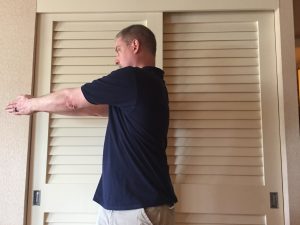A few years ago, I noticed that I started getting angry at night before going to bed.
It would happen when I laid on my back in bed to read, but not when I propped myself up and laid on my stomach.
I finally figured out that it was the LED lights that we’d installed in our bedroom.
We were trying to get our kWh down as low as possible so we could use a smaller generator when the power went out and LEDs seemed to make sense.
Except for the fact that my eyes don’t like overly white/blue light.
At all.
When I was looking up at the lights, it affected me much more than when the light was bouncing off of a dark wood headboard before getting to my eyes.
Being the “recovering engineer” / bio hacker that I am, I dug into it to see how many ways light affected me and how much I could manipulate the effect.
I noticed that there were times when I was on the bubble when a change in lighting could change my mood, strength, speed, attitude, energy level, and more.
I found that fluorescent and LED lights are a form of kryptonite for me…as they are for many.
So, I set up lights that let me change output from 2700k (“warm” light that’s yellowish, like a candle or incandescent bulb) up to 5000k (“cool” light that’s white…almost blueish) and started running tests.
My initial results were shocking.
I could switch back and forth between light colors and see up to a 20% change in reaction times…within seconds.
As I tried it with others and dug into the research, I found that these kinds of results are fairly common.
Changing lighting could make a difference on reaction times, vision speed, transition speed, and more.
This is great if you can swap out the lighting where you’re shooting, but what if you can’t?
That’s where the lenses of your glasses come in.
Now, I wish I could just tell you to get a certain kind of glasses and be done with it, but the fact is that my neurology is probably different from yours, and your friends, and their other friends.
So, here’s how you figure out the best shooting glasses FOR YOU.
The right glasses will probably depend on the kind of light that you’ll be shooting under but for the majority of people, they’re going to perform better wearing glasses that block out excess blue, like my friend Jordan demonstrates here:
Impact Of Blue Light On Strength from Average To Elite Performance on Vimeo.
You may do better with different lenses depending on whether you’re shooting under incandescent light, LED/fluorescent light, or outdoors.
I shoot best with amber or reddish lenses inside under LED and florescent light and polarized lenses outside under natural sunlight.
For indoor shooting, I suggest figuring out the best lenses under cool lighting…which is what you’ll find in most retail locations that use LEDs and fluorescent light.
What you’re going to want to do is follow this pattern: Warm up-Baseline assessment-Test-Re-assess
I’ll give you 3 assessments that you can use, but you may have one that you already know that works well for you.
Three of the assessments that I use are:
- Toe touch flexibility
- Balancing on one leg
- Rotating at the waist with the feet solidly on the ground, shoulder width apart and testing range of motion of your arms.
Let’s take the toe touch as an example.
What you want to do is warm up by bending forward as far as you can without pain. It doesn’t matter whether you can only touch your knees, touch your toes, or touch the ground 8” behind your heels.
Just do it a few times to get warmed up and get a baseline of where your flexibility is at.
Now, pick a lens to wear, walk 5-10 paces, turn around, go back to where you started, and test your flexibility without pain again.
There may be no difference at all, you could see a positive effect, or a negative effect.
Keep trying different lenses and different colored lenses until you find the one that your brain likes the most.
At any point, feel free to go back to assessing your flexibility without any lenses on to see if your flexibility has changed from the baseline. There’s no reason to use carny tricks to create a false result…you want REAL results.
Here’s the thing. Ideally, your brain will be so resilient that changing lenses won’t make any difference at all to how well you perform–that’s just not normal.
So, if you don’t see any difference with any lens, that’s a very good thing.
For balancing on one leg, this assessment works if you can consistently stand on one foot for 5-10 seconds without getting wobbly or falling. If you can’t do it for 5 seconds, or if you stand like a statue for 15 or more seconds, then this isn’t an effective assessment for you.
For rotating at the waist, it’s important to keep your hands together and don’t let them slide and it’s important to keep your feet flat and don’t let them roll at all. If you slide your hands or roll your feet, you can create the appearance of an increase in flexibility where it doesn’t really exist.



Again, the goal here isn’t to show improvement…it’s to accurately assess whether or not your brain likes one pair of glasses or lenses better than another.
What about shoes?
With shoes and sandals, you can go through the same assessment and re-assessment process, but in addition to walking a few paces, you want to stimulate the cerebellum a little by gently (no pain) bouncing up and down on your heels a few times.
With just these 2 factors…glasses and shoes…you can generate some pretty amazing (and nearly instant) changes in performance without even having to change technique.
They’re changes that will not only help you shoot better with less effort, but they’ll improve your overall quality of life during the 99% of the time that you’re not shooting.
This is an example of some of the high-speed performance neurology based drills that we cover in Draw Stroke Mastery and it’s how we’re able to help shooters make way more dramatic improvements in performance than what’s possible with traditional firearms training approaches.
If you’re serious about self-defense performance with a pistol, or if you just find yourself way too short on time to do the training you want to do, you need to check it out now by clicking >HERE< Make sure to check out the new bonus items and bonus training.
Questions?
Comments?
Fire away by commenting below.
2 Comments
mot yeliab
September 11, 2019A few decades back, while on the hunt for glasses or contacts that would help with my colorblindness, I stumbled across an eye doc that relayed to me about some research the then Soviet Union had been conducting for several years at THAT time.
Because colorblindness is NOT on the list of priorities in vision research, I was offered a ‘red lens’ but just one to wear in my left eye(it could be the other eye for someone else) to which I immediately jumped on in hopes of seeing something similar as “normal” folks.
What happened in my case was, greens turned what I think is black and reds became so brilliant and fluorescent that I honestly could no look at the color red. To others I looked like something out of Stephen King spook books. Obviously with the red/green issues, driving was very risky to other drivers and night driving was all but over.
I stopped using the lens after a couple years and just went back to where I was. Then one day, needing sun glasses I zipped into Kmart to see what they had. I came across a pair with Rose colored lenses. All of a sudden, I began seeing colors and shades of colors that I had never experienced before. Keeping this as short as possible, I want to just share this in hopes someone else might find the right solution that will help them.
One last caveat however is, finding rose colored lenses in sun glasses that are actually affordable is very difficult. I have found them on one of my favorite sites that sells tons of eyewear including sunglasses. Be sure though guys and girls, when you are going to try the sun glass route, don’t assume that RED will do the same thing, for me it DID NOT i.e. the mention of the red contact lens above. For me it has to be ROSE and if you order them online make double sure that you are getting the lens color that you are wanting. I have been burned a couple times when the seller sent ‘rose colored frames and not lenses.’ So happy hunting and may your search be fruitful.
Ox
September 11, 2019That’s great! Sometimes, (actually, a lot of the time) I just cover the surface of a topic because the full depth of it is unbelievable and/or makes people’s heads spin on their shoulders.
A lot of people with glaucoma wear rose colored glasses. Bono from U2 has glaucoma. The mom from “Alaskan Bush People” has glaucoma. When you realize what’s going on, you start seeing rose colored glasses more and more.
As far as the particular color…there’s a TON of neurology there. For people who specialize in lens/colored light therapy, they’ll have people put on a series of 8 or more different colored/tinted lenses and have them do stretch and strength tests to see which colors make the brain feel less threatened and which make the brain feel more threatened. Once you know your particular “best” colors, the impact can be pretty dramatic.
Thanks so much for sharing.
Leave A Response To mot yeliab Cancel reply